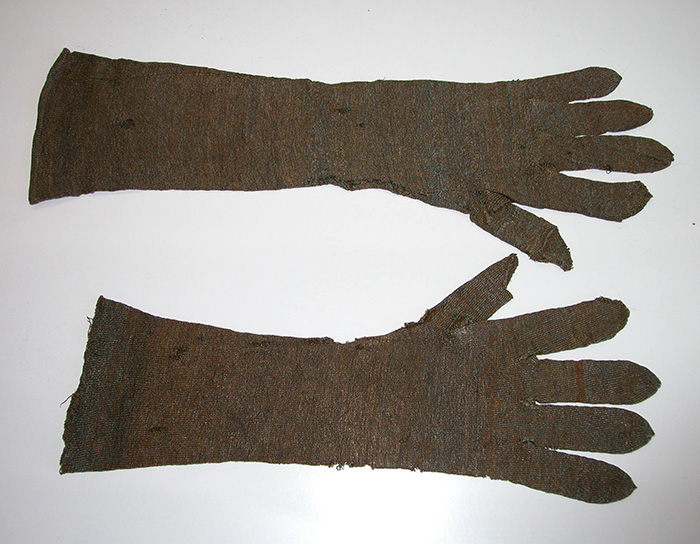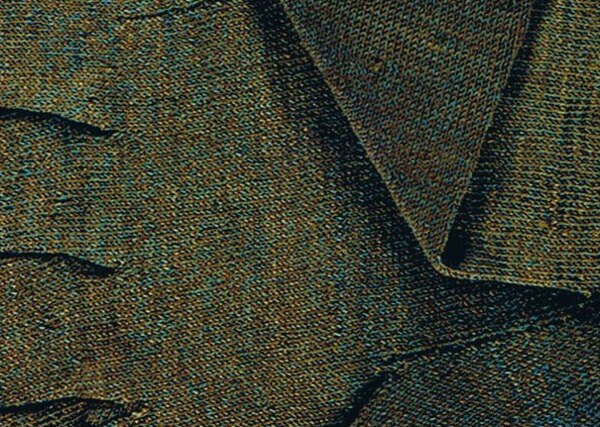Pair of ladies’ gloves, 18th c.
Pair of ladies’ gloves, elbow length, end of 18th century, I-Taranto. D-Rostock, Zoological Collection of the University, Inventory No. VII Ba. 54 (MS-Inventory 3).
Sea silk and twisted light blue thread (mulberry silk?), thumb and forefinger open, fingernail covered, plain right knit, 10 stitches/cm, l 37 cm, width wrist 6,5 cm, width end 9,5 cm, small holes, hand edges damaged.
Original label: … ein Geschenk der Frau Reichsgräfin zu Stolberg … Sophia, 21. Nov. 1799, (in English: … a gift from the Countess of Stolberg … Sophia, 21 Nov. 1799).
Friedrich Leopold Count of Stolberg (1750-1819), lawyer and writer in Berlin, married 1790 in second marriage Sophie Charlotte Eleonore von Redern (1765-1842). During a journey to Italy, he was a guest of Archbishop Giuseppe Capecelatro in Taranto from May 7th to 12th, 1792, about which the count reports in detail in his diary. Mention is also made of the gloves made of sea silk, which the archbishop gave him as a gift.
“Man macht hier eine Arbeit, welche von Müttern auf Töchter, vielleicht noch von der Griechen Zeit her, sich erhalten hat. Eine Art Muscheln, welche Pinna heisset, deren kleinsten einige Zoll, die grössten wohl eine Elle lang sind, hat einen Büschel feiner Haare oder Fasern von glänzender grüner Farbe. Der Erzbischof hatte die Güte, einige Weiber rufen zu lassen, damit sie in unsrer Gegenwart arbeiten möchten. Die Art zu verfahren ist einfach. Die Büschel werden von der Muschel abgenommen, erst zweimal in Seifenwasser, dann in lauterm Wasser dreimal gewaschen, gleich nachher gehechelt, und auf der Kunkel gesponnen. Man nimmt dreifache Faden, dreht sie, und strickt daraus Handschuh, Strümpfe, auch ganze Kleider. Sie haben den Glanz des drap de Vigogne, tragen sich angenehm, und sehen schön aus. Man strickt auch mit zween solchen zusammen gelegten Faden, und fügt einen dritten von Seide hinzu. Die Arbeit wird alsdann dauerhafter, aber minder schön. Diese Zeuge verlieren ihren Glanz und ihre grüne Farbe, wenn sie bei wolligen Zeugen liegen. Noch schädlicher sind ihnen alle Gerüche. In Leinenzeug verwahrt man sie am besten. Den durch Gebrauch verlornen Glanz stellt Citronensaft itt Wasser wieder her. Eine Frau, welche uns diese Arbeit zeigte, schenkte mir kleine Proben von noch rohen Faden, von gewaschnen, gehechelten, gesponnenen und gestrickten.” (Stolberg 1794), (in English: The work done here is a work that has been preserved from mother to daughter, perhaps from the Greek period. A type of mussel called pinna, the smallest of which is a few inches long, the largest probably a cubit, has a tuft of fine hairs or fibres of a shiny green colour. The archbishop was kind enough to call some women to come and work in our presence. The way to proceed is simple. The tufts are removed from the mussel, first twice in soapy water, then washed three times in clean water, panting immediately afterwards, and spun on the distaff. You take triple thread, twist it and knit gloves, stockings, even whole dresses. They have the shine of the drap de Vigogne, are comfortable to wear and look beautiful. You can also knit with two threads and add a third one of silk. The work then becomes more durable, but less beautiful. These textiles lose their lustre and green colour when they lie on woolly fabrics. All smells are even more harmful to them. It is best to keep them in linen cloth. Lemon juice and water restore the shine lost through use. A woman, who showed us this work, gave me small samples of raw thread, of washed, hackled, spun and knitted.)
“margine, simpatico e significativo è l’episodio ricordato da Stolberg: la donna invitata dal Capecelatro per spiegargli tutti i passaggi della lavorazione, si inorgoglisce e si commuove per l’interesse e gli apprezzamenti manifestati dallo straniero. Il giorno dopo Stolberg con sorpresa, riceve in dono dalla donna un paio di guanti, segno tangibile della sua riconoscenza. Sebbene di umili origini e forse analfabeta, la sconosciuta tarantina ha dato prova di grande dignità e garbo tanto da colpire la sensibilità di Stolberg il quale ha avvertito la necessità di tramandarci l’episodio.” (Girelli Renzulli 2000), (in English: … nice and significant is the episode mentioned by Stolberg: the woman invited by Capecelatro to explain to him all the steps of the work, is proud and moved by the interest and appreciation shown by the foreigner. The next day Stolberg is surprised to receive a pair of gloves as a gift from the woman, a tangible sign of her appreciation. Although of humble origins and perhaps illiterate, the unknown Tarantine woman showed great dignity and courtesy, so much so that it struck Stolberg’s sensibility that he felt the need to pass the episode on to us.)
More about this in the chapter Historical Aspects → Modern Times → Giuseppe Capecelatro.
Count Stolberg corresponded with Elisa van der Recke, who was also a guest of Archbishop Capecelatro in 1815 (Hempel 1997). In 1800, the Stolberg couple converted to Catholicism and moved to Münster, where they were accepted into the circle of Countess Amalie von Gallitzin.
Countess Sophia zu Stolberg donated these gloves to the founder of the Zoological Collection in Rostock, Prof. Dr. Oluf Gerhard Tychsen (1734-1815) in 1799.


